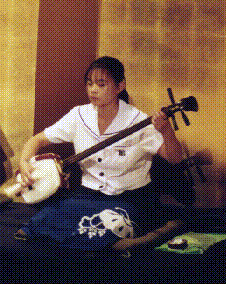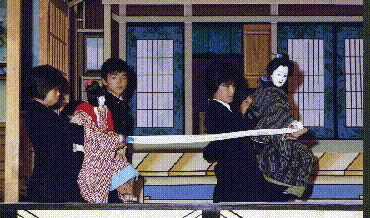

Japanese Home page click here
日本語のホームページはここをクリックしてください。
Since its establishment in 1952, the club has continually striven
to preserve and propagate the Awaji Puppet Theater which has been
prevailing for over 400 years on Awaji Island in Japan.
During the post war period, the Awaji puppet tradition has nearly
fallen into extinction. The club, however, has overcome all diffi-
culties to preserve the tradition. The club's performance actvities
are widespread---including those at All-Japan Senior High School
Cultural Festival, perfomances all over Japan. In 1993, the club
has won the first prize at the folk performing arts branch of the
17th All-Japan Senior High School Cultural Festival held at Saitama
prefecture. As its result, honorably, the club could perform at the
National Theatre of Japan. In foreign countries such as the US,
Germany and Spain, some members of the club performed as guest
members of the Awaji Puppet Play Theater these years.
The Awaji Puppet Theater is a combination of three skills;puppet mani-
pulations, joruri recitation and samisen music, each of which requires
many years of training to master.

The dolls of the Awaji Puppet Theter are about half life-size.
Their eyes move, their eyebrows rise in surprise, their mouths open
and shut and their hands and arms work realistically.
Each of the principal dolls is operated by three manipulators.
The manipulators carry the dolls on to the stage and are visible
throughout the play.

The chief manipulator holds the puppet from the back with his
left hands by a special grip in the puppet's chest and directs the
puppet's right arm with his right hand. As a female doll has no
legs as a rule, the third operator moves its skirt in such a way as
to create an illusion of moving legs.

The joruri recitor, who tells the story, which the puppets act,
and who chants, shouts, whispers or sobs the dialogue for all
characters appearing in the play, sits with his (or her) samisen
accompanist.
Voice of a joruri recitor(0.2MB)

The samisen accompanist play an important role in the puppet show.
The samisen provides not only a musical accompaniment to the joruri
recitation but also an imitation, where appropriate, of the sound of
rain or wind or other effects to heighten the atmosphere of the scene.
Sound of a samisen(0.2MB)

We often perform this drama.
Sound and voice of this story(0.2MB)
This story was premiered in 1768 at Takemoto Theater, Osaka.
Jurobei, a masterless samurai from Awa (Tokushima prefecture)
is forced into the life of an outlaw under the assumed name Ginjuro
with Oyumi, his wife while searching for his stolen, priceless sword.
The curtain rises on their residence in Osaka. To this house coin-
cidently comes their daughter Oturu, who was left in Awa. As Oyumi
talks with Oturu, she recognizes her as her own daughter, but her
daughter not. Without disclosing her identity, Oyumi orders her to
go back to Awa in fear of mixing her daughter up in troubles.
Afterwards Oyumi changes her mind to live with her daughter, and
pursues her. However, on her way back to Awa, Oturu is killed and
robbed of her money by her own father, Jurobei, who doesn't know
she is his own child. This story has such a sad ending.
